How to Build an Effective SaaS Marketing Content Strategy
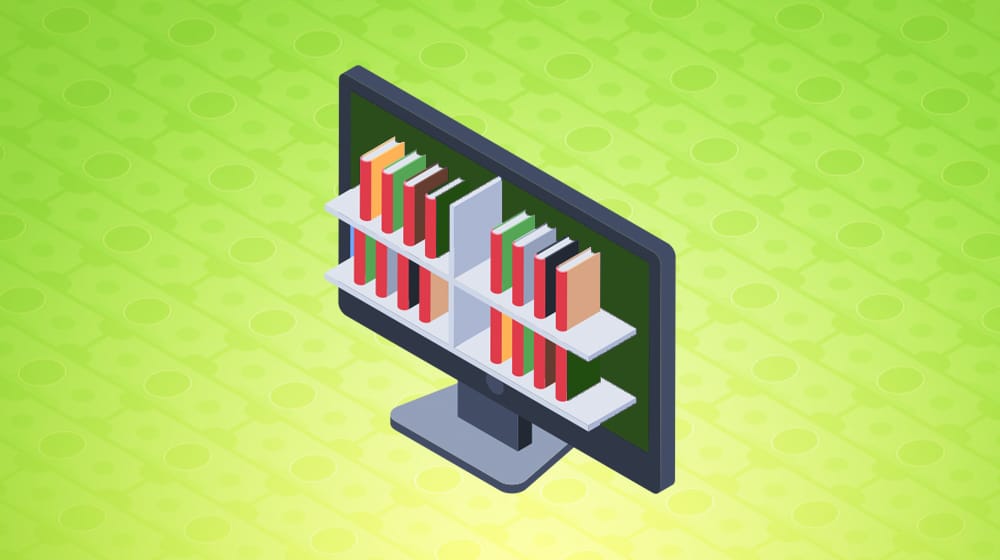
Every year, content marketing becomes a bigger and bigger part of everyone's ongoing marketing efforts. Fewer and fewer people are watching television or listening to the radio, making such broadcast marketing much less effective. Online paid advertising is often ignored, subject to banner blindness, or simply blocked with browser tools. It's harder and harder to reach people through traditional marketing channels.
Content is one marketing channel that perfectly mimics organic value, and as such becomes a perfect form of marketing. People don't realize just how advertorial content is; they just know they get value out of it, and that's often enough.
Content, targeted properly and with enough depth, can draw in a wide range of new visitors who would never have found your company otherwise. Content, through persuasive writing and deep value, can convince those users that you're worth recognizing, returning to, and acknowledging as a service provider. Content, with the right focus on problems and solutions, can convince those users that you have the solution to the issues that ail them.
If you do it right.
Content marketing is a lot more complicated than many people think. There's a lot of research, behind the scenes testing and tweaking, monitoring of performance, and general exploration of what does and doesn't work. Moreover, the best content marketers strive to make every single post a highly valuable mark of what their company can do. All too many businesses start with keyword research, end with a basic post, and wonder why it barely works.
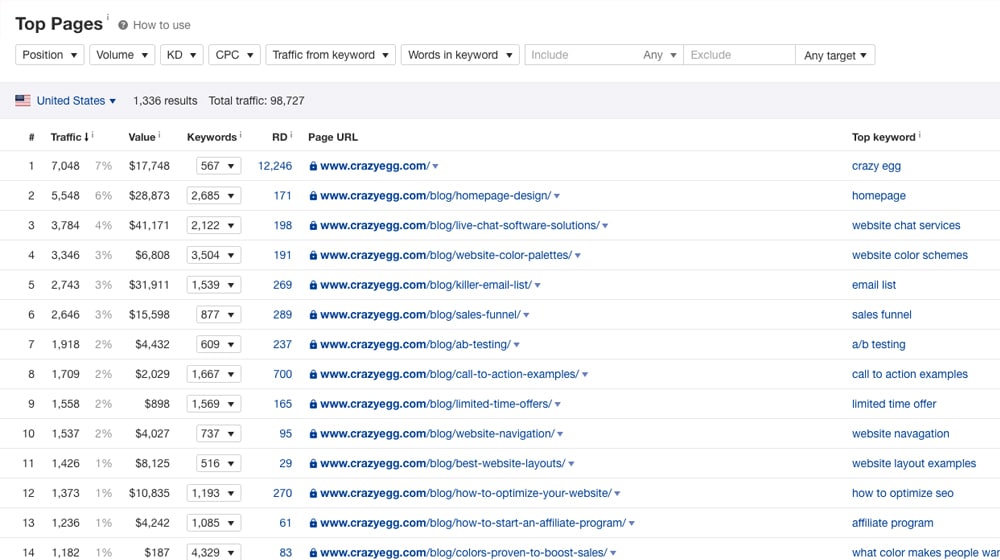
Years and years ago, when content marketing was new, that kind of low-effort strategy did work. As the years have gone by, it has worked less and less; the standards, the depth, the competition, it has all been driven up by the number of new businesses and entrepreneurs entering the space. We're probably only a few more years away from reaching a point where it simply doesn't work for most people, and we'll experience a shift towards another new form of marketing.
For those willing to put in the effort to develop a content strategy, content marketing still works. It works extremely well. It's just a high bar to clear. So, let me help you clear it, won't you?
 30 Second Summary
30 Second Summary
Traditional marketing methods are gradually losing their prominence. People often disregard online paid ads and viewership for television and radio shows has seen a decline. Content marketing, however, provides value and often doesn't present itself as simply an advertisement to users. Well-crafted content can attract new visitors, build brand recognition and provide solutions for their issues. Although it may appear to be a straightforward process, content marketing calls for intricate planning, research, analysis, and monitoring. Successful content marketers focus on creating value in every post. Understanding how content marketing works, analyzing customers, the sales funnel, and developing content strategies form the core basis of this process.
Step 1: Understand How Content Marketing Really Works
There's this idea that content marketing involves posting blog posts and then something magical happens and you get more customers. That's like saying you get into your car and then something happens and you end up at work. It describes the process, sure, but it leaves out a lot of the details along the way.
The actual process is one of the cycles. You create content and post it. People find it and visit it, and read it, and maybe some of them enjoy it. You post more content, and more people find it and maybe enjoy that content. Some of them are new visitors, but some of them have come back after seeing the first bit of content.

In this way, you gradually build up people who keep coming back to read your content. As you go, you study those people and figure out who they are, what they're looking for, and what content you can give them to provide them with the best experience you can. You know, related to your niche, anyways.
Over time, people stop just finding your content, and they start seeking out your content. They start to remember your name. They start bookmarking your URL. They start following your social media accounts. Instead of treating you like just another resource that they find online – albeit a good one – they start treating you as a specific, reputable entity.
You build up this trust and this relationship by doing more than just posting content and linking to it on social media. You hold conversations. You accept and respond to blog comments and comments on your social media posts. You start to recognize the people who comment most often. You engage with your audience, and they engage with you.
All the while, through your content and the surrounding elements of your site, you're adding calls to action. These calls to action are ignored by the majority of the people who visit your site, but sometimes, someone visits who has a specific problem. They have a problem, and they see you writing content about that problem and how to solve it. So how do they solve it? With your SaaS product, of course. So they click on the call to action and they take action.
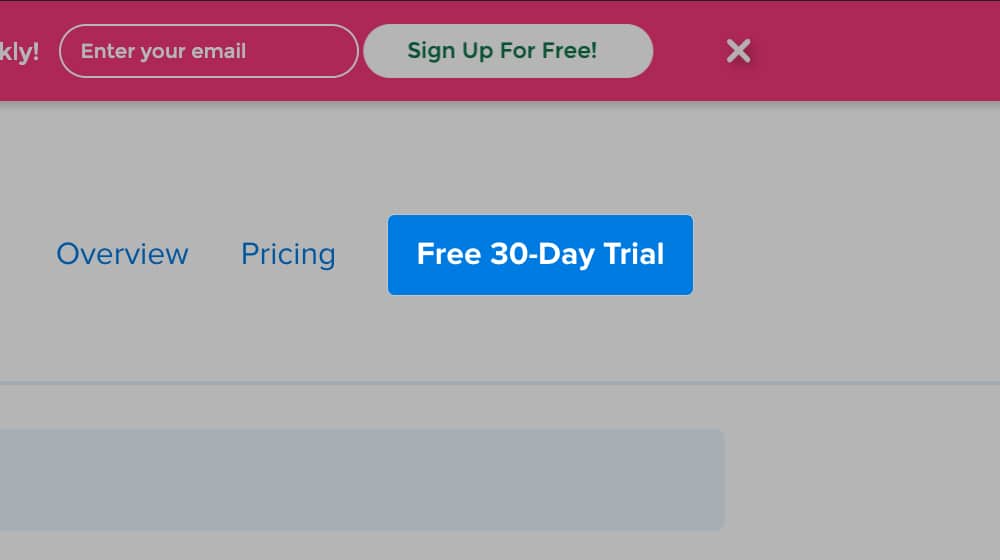
Other people might know they have a problem, but they don't immediately go to your content. Rather, they start researching the problem, and they find that five different companies all offer a solution to that problem. So how do they pick which one is the best? They'll look up reviews, they'll compare prices, and all the rest of the shopping experience, but they already have one of the most influential through-lines to you: being your fan already. They're biased towards you because they know your content, they know your reputation, they've engaged with you. They trust you, and so they pay you to solve their problem.
There's a lot more to it than just posting some blog posts, huh?
Step 2: Analyze Your Customers
There are two things you need to learn about your customers before you can effectively market content towards them.
- Who they are.
- What path they take to conversion.
Learning who your customers are allows you to determine everything about them. To a certain extent, what you need to do is develop buyer personas. Here's a whole guide on doing that.
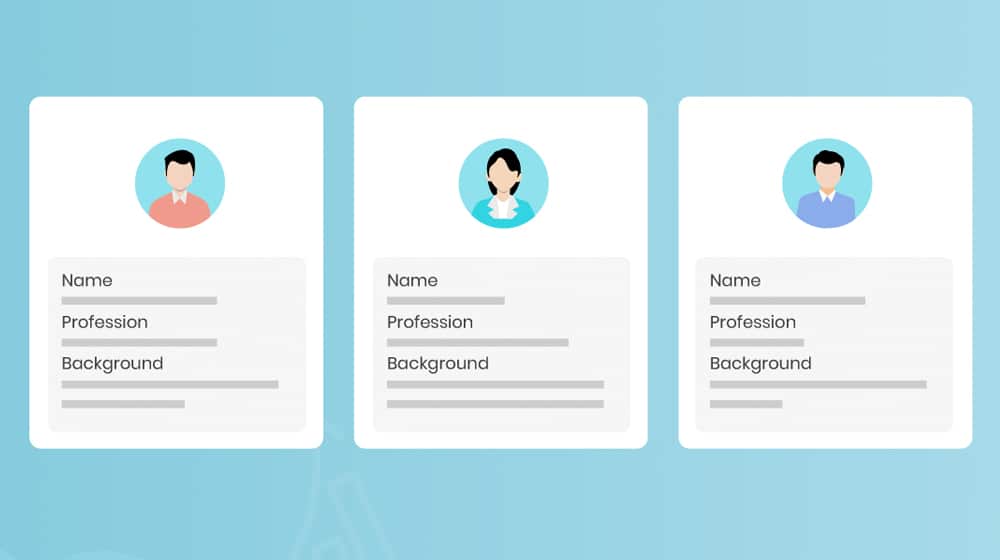
Recognize, though, that buyer personas only go so far. In fact, for a SaaS company, they might be less than an idea. Why is that?
For a B2B purchase, the decision is rarely a single person's decision to make. You're not trying to reach one particular C-level executive with your marketing, or one HR manager, or one IT director. You're trying to reach a team of people that includes people like:
We create blog content that converts - not just for ourselves, but for our clients, too.
We pick blog topics like hedge funds pick stocks. Then, we create articles that are 10x better to earn the top spot.
Content marketing has two ingredients - content and marketing. We've earned our black belts in both.
- The leader. This is the person who has the overall strategic vision. They know what direction their company is headed, or where they want it to be headed, and they're in charge of putting together the plan to get it there.
- The researcher. This is the person who is in charge of working with the leader and taking their overall plan, distilling it down to specific tasks that need to be accomplished, and finding the kinds of tools and systems that need to be used to accomplish it.
- The implementer. This is the person who takes the actionable bullet points and tasks the researcher has developed and picks the tools, software, platforms, and resources needed to actually get it done.
All of these people must agree on the benefits of using your platform over the other options on the market, and they will all have different concerns. One might ask "does this do X?" One might ask "how much does this cost?" One might ask "can we integrate with Y?" Your content marketing plan needs to address all of these questions.
If your immediate reaction is "that's impossible", well, you're right. You can't put together one single piece of content that reaches all of these people and convinces them. Your content marketing plan overall needs to be able to reach each group with their own kinds of targeted content.
Step 3: Analyze the Sales Funnel
Above, I mentioned that there are two things you need to learn about your customers, and then I expounded upon one of them. Now let's talk about the other: the path your readers take between discovering you and converting.
The sales funnel, the buyer's journey, whatever you want to call it, you need to understand the different levels of user engagement that lead up to a sale. You need to look at this from two perspectives:
- Top-down: how your broad awareness should filter down to a conversion.
- Bottom-up: how your real, actual customers have filtered down to a conversion.
A sales funnel, from the top down, will generally look the same from company to company and situation to situation. You start with broad awareness. Your content marketing, your paid ads, your social media, all can be aimed at growing your potential audience and reaching new people. Next, you turn some of that awareness into leads. You capture the people who are most interested and get them to do things like download e-books, sign up for notifications, and join your newsletter.
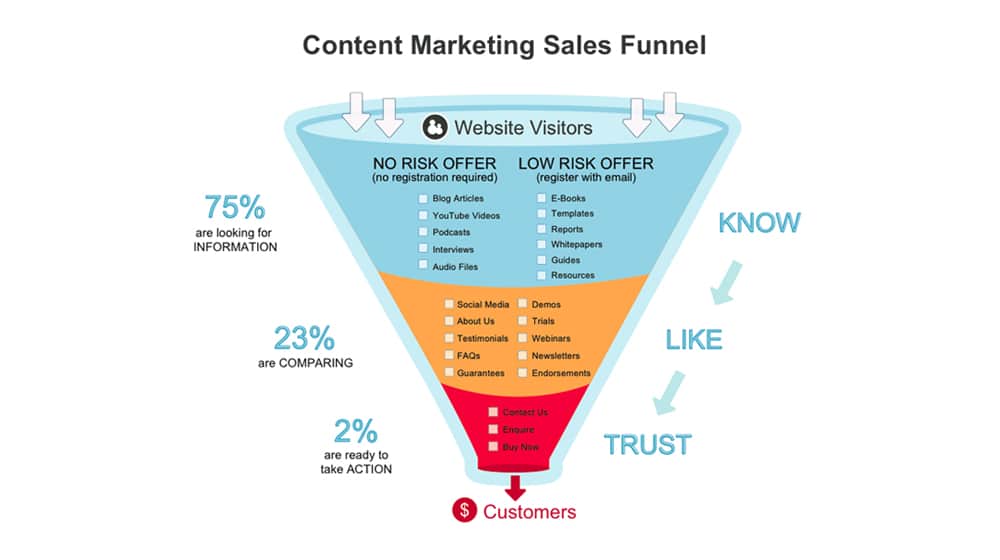
From there, you focus on converting those people into people who are willing to give your platform a trial run. Depending on your platform, you may to add a sales call to your funnel, or it may be more self-motivated with an open sign-up. And, of course, you get these people to roll over their free trial into a paid subscription to your SaaS offering. Some sales funnels even go one step further and add on the customer retention layer, though that generally has less to do with content marketing and more with customer satisfaction, so I'm leaving this out. This is a good guide if you want to read up more on customer retention methods.
From the bottom up, you need to look at your existing customers and trace the actual, real journeys they have taken to get there. Answer questions like "how did they first hear about you?" and "what convinced them to give you a trial?"
Ideally, you will have data tracing this path, but if you haven't had tracking set up all along, you'll need to get it going now. You can, meanwhile, send out surveys to your existing customers and ask them for data about their path through your funnel, though of course, you should couch it in friendlier terms. Ask "where did you first hear about us", not "when did you first get sucked into the gravity well that is our inescapable marketing?"
Step 4: Develop Content Plans for Each Stage
The tricky thing about the sales journey is that while we think of it as a funnel where customers progress through each stage in a linear fashion, it's more of a jumbled mess. Some customers bounce in and out when they encounter roadblocks. Some sit at one part of the funnel for years before taking the next step. Worse, though, is that all stages of the funnel are active at all times. You can't simply order your content as though you're following customers through the journey because every single day there will be people at every different step along the way. Your content needs to reach all of them.
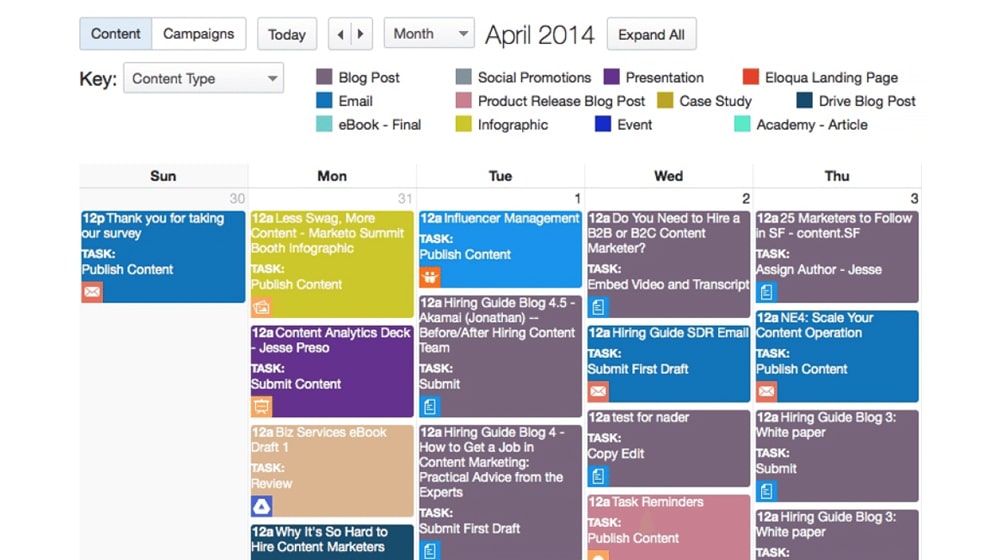
So, what do you do? You develop content that can reach each stage of the funnel. Divide up your funnel and figure out what each type of user is going to be looking for at each stage in their journey. You'll end up with a dozen or more different broad categories of content, things like :
- "Content that makes them aware of our brand and tools"
- "Content that digs into common problems the leader archetype is experiencing"
- "Content that explains how to implement our tool to solve X problem"
These are just a few examples. You can get into lists, reviews, guides - anything and everything that accomplishes those goals.
- For awareness, you'll have content that targets broad, top keywords. You're not necessarily going to dominate the search results, but you want to be present and available. You're not selling anything with this content, you're just making people aware that you exist.
- For lead generation, your goal is to talk about the kinds of problems your users face and the kinds of solutions you can offer them. This ranges from content about your platform and how it helps, to content about DIY solutions to common problems. You want to be useful and valuable to people who haven't bought in, as an implicit promise: if you're this helpful now, imagine how helpful you'll be once they're a customer.
- For people on the free trial, you want to create content that hooks them on using your product. The tutorials, the problem solving, the resources; this is where it all kicks in with specific, narrow value.
This is just a general overview, of course. You'll need to customize it all to your specific set of customer archetypes and sales funnel positions.
Step 5: Narrow Down Specific Content Ideas
Once you have categories for your content, you can start filling those categories out with ideas. This is where you'll put the full might of your keyword research and topic ideation skills to work. Look at what competitors are writing. Look at what customers are asking for. Look at what keywords have high volume. Look at what features are in demand. Look at anything you can and use it to develop content ideas.

There are, of course, a million different tools out there to help you with topic ideation. Everything from Alexa's keyword tools to Google's auto-suggest to utilities with funny names can all be of use. No idea is a bad idea unless it drives people away.
Utilize a wide range of techniques. Give every tool you find a try. Keep a gigantic spreadsheet with content ideas, keywords you've researched, content competitors have written, questions people have asked, notes you've taken while half-asleep at 6 AM trying to find your coffee in a bleary haze, everything. Treat this as a mountain you mine for gold whenever you need new content.
Step 6: Write, Analyze, Iterate, Write
All of the above is developing a basic content plan, but that's just it: it's basic. Until you put it into action, it will remain basic. Even once you put it into action, it will stay basic. Do you know what turns it into an advanced, powerful content plan, instead of just a basic content scheme? Analysis and iteration.
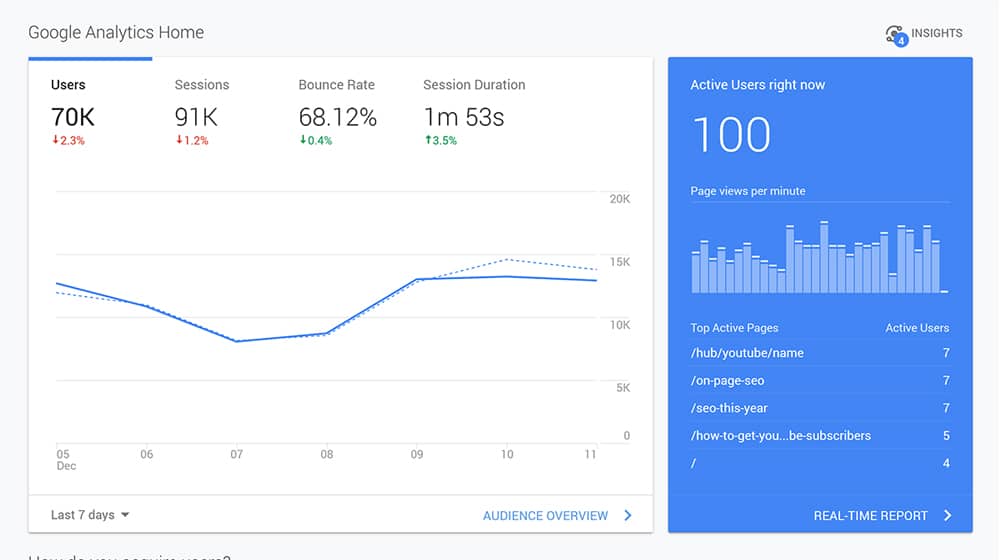
Every piece of content has a purpose. Whether it's aimed at building awareness, solving a problem, or selling your platform, it has a specific goal in mind, and that's a goal you can monitor with your analytics.
How your users react to the content tells you a lot. Some of them may fall deeper into the funnel because of it. Some of them may bounce away. Some of them will show you something about themselves that leads to changing an existing archetype or developing a new one. Harvest that data, use that data, and iterate on your content plan. No data is bad data unless you fail to utilize it.
That, my friends, is the heart of good content marketing.



 30 Second Summary
30 Second Summary

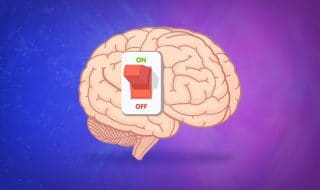
August 01, 2020 at 7:43 am
It was not easy for me starting up my blog along with the my online shop. It's a mix effort optimizing my online presence and do something locally which is my product's market. I participated on events, reach out to local radio station and doing some collab with Youtubers who are happy to work with me for free. I utilize everything I can use online even though some platforms does not perform as much as the other, at some point those will be worth it. Discovering what "Sales Funnels" are was the start of me feeling like I am on the right path so keep on digging data non-stop and use the tools available to its full potential.
August 03, 2020 at 11:50 am
Hey Gilbert!
If you're creating great blog posts to promote your store, you're already a step ahead of the curve.
Choosing the right topics is where I see most business blogs fall flat - it's a good idea to focus on "evergreen" topics that will still be relevant and drive traffic for years to come, but you also want to ask yourself "Is anybody actually searching for this?", and if the answer is "Probably not", then you should think long and hard before investing the time and money into writing about it. Of course, competition comes into play, so if it's way too saturated your article may never see the light of day.
We wrote an article about evergreen topic ideas and examples that you may be interested in, here:
https://www.contentpowered.com/blog/evergreen-blog-ideas-examples/
September 30, 2020 at 11:32 am
Do you think it's practical to enroll in a content marketing class?
October 05, 2020 at 8:11 pm
Hey Richard! I don't see why not, as long as the pricing is right and it's from an educator that you know and trust. Learning about content marketing is a very valuable skill.
Have you heard the phrase "coaches teach coaches how to coach"?
That's the only thing I'm worried about from a lot of these coaches - they became very good at coaching but they don't necessarily understand the intracacies of content marketing. Many of them haven't owned any successful sites that were grown with content marketing.
My recommendation is to do your due diligence and find someone that is reputable and knowledgeable.
Good luck and I hope you find what you are looking for!
January 06, 2021 at 4:45 am
Thanks for sharing this guide, James. It seems like a lot of work but it helps to know what is involved with a strategy like this I suppose.
January 08, 2021 at 9:34 pm
Hey Susan!
Absolutely. It's a lot more work than most people realize.
We wrote a blog post on this very topic, just to make a point on what is really required to be successful:
https://www.contentpowered.com/blog/content-marketing-more-difficult/
If you want to see results, you can't compete by doing everybody else is doing - you have to outperform them.
I'm glad this helped you!
January 20, 2021 at 9:45 pm
I have a blog and I am thinking of creating an e-book using the articles that I already have. you think that works?
January 22, 2021 at 10:13 pm
Hey Kevin,
Absolutely! I've done this in the past with success, as well as a handful of my colleagues.
I just wrote a blog post on this very topic a couple of weeks ago, check it out!
https://www.contentpowered.com/blog/turn-blog-posts-ebook/
Hope it helps you.
May 17, 2021 at 10:31 am
Great stuff. Are a lot of your clients SaaS companies?
May 19, 2021 at 3:23 pm
Hey Megan!
We have a handful of SaaS clients, but I think our most popular client type is eCommerce.
Blogging makes so much sense for SaaS companies, especially those offering a free trial.
Profit margins are high, free trials reduce signup friction, and the ROI is fantastic. It's why most SaaS startups invest so heavily into their blogs.